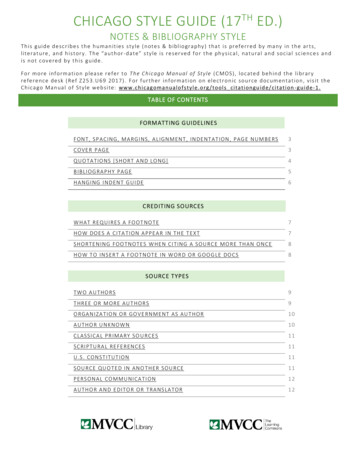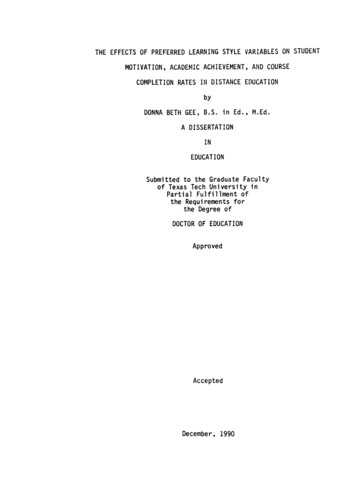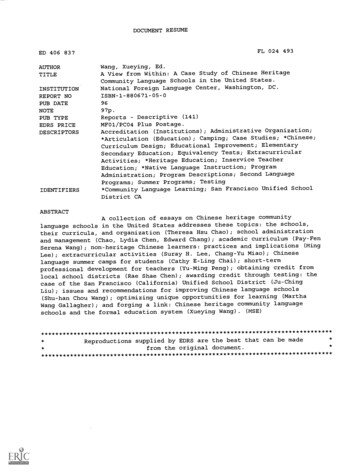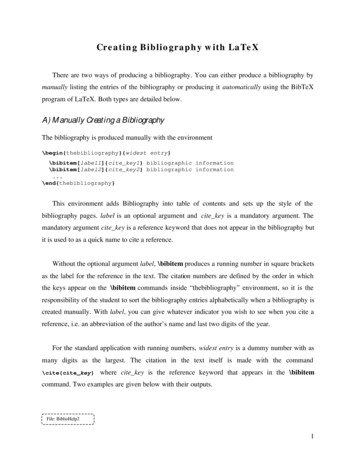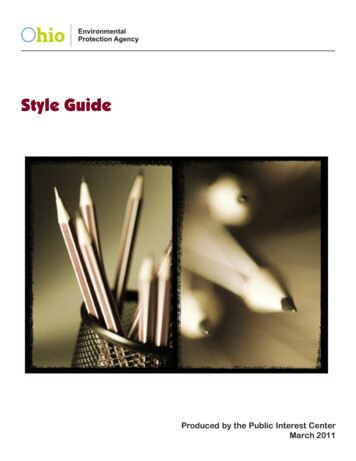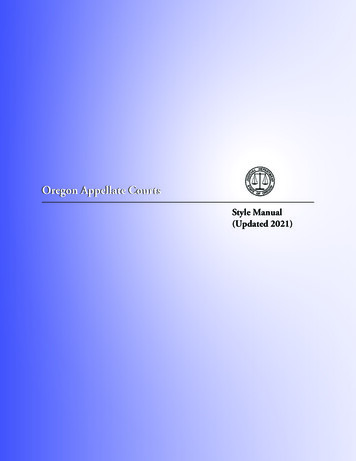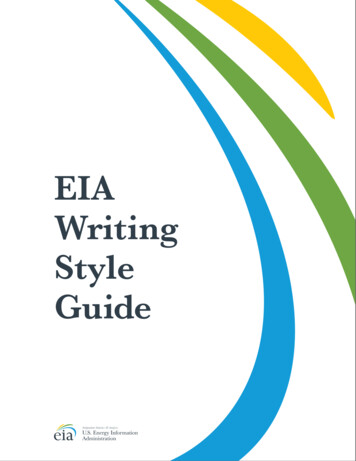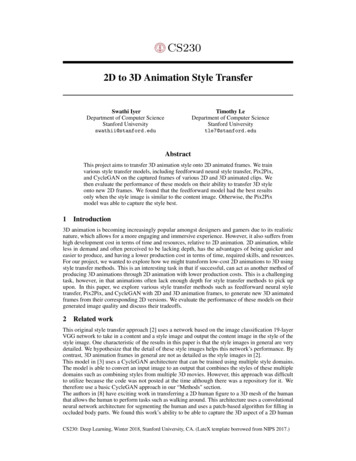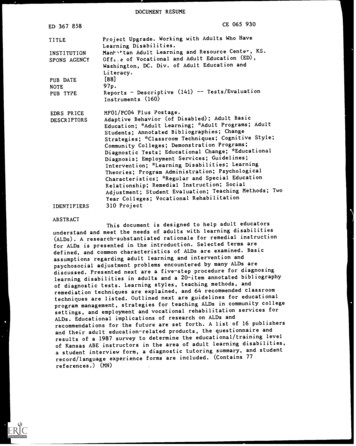
Transcription
DOCUMENT RESUMECE 065 930ED 367 858INSTITUTIONSPONS AGENCYProject Upgrade. Working with Adults Who HaveLearning Disabilities.Manl,*tan Adult Learning and Resource Center, KS.Offl,e of Vocational and Adult Education (ED),Washington, DC. Div. of Adult Education andLiteracy.PUB DATENOTEPUB TYPE97p.TITLEEDRS PRICEDESCRIPTORSIDENTIFIERS[88]Descriptive (141)ReportsInstruments (160)Tests/EvaluationMF01/PC04 Plus Postage.Adaptive Behavior (of Disabled); Adult BasicEducation; *Adult Learning; *Adult Programs; AdultStudents; Annotated Bibliographies; ChangeStrategies; *Classroom Techniques; Cognitive Style;Community Colleges; Demonstration Programs;Diagnostic Tests; Educational Change; *EducationalDiagnosis; Employment Services; Guidelines;Intervention; *Learning Disabilities; LearningTheories; Program Administration; PsychologicalCharacteristics; *Regular and Special EducationRelationship; Remedial Instruction; SocialAdjustment; Student Evaluation; Teaching Methods; TwoYear Colleges; Vocational Rehabilitation310 ProjectABSTRACTThis document is designed to help adult educatorsunderstand and meet the needs of adults with learning disabilities(ALDs). A research-substantiated rationale for remedial instructionfor ALDs is presented in the introduction. Selected terms aredefined, and common characteristics of ALDs are examined. Basicassumptions regarding adult learning and intervention andpsychosocial adjustment problems encountered by many ALDs arediscussed. Presented next are a five-step procedure for diagnosinglearning disabilities in adults and a 20-item annotated bibliographyof diagnostic tests. Learning styles, teaching methods, andremediation techniques are explained, and 64 recommended classroomtechniques are listed. Outlined next are guidelines for educationalprogram management, strategies for teaching ALDs in community collegesettings, and employment and vocational rehabilitation services forALDs. Educational implications of research on ALDs andrecommendations for the future are set forth. A list of 16 publishersand their adult education-related products, the questionnaire andresults of a 1987 survey to determine the educational/training levelof Kansas ABE instructors in the area of adult learning disabilities,a student interview form, a diagnostic tutoring summary, and studentrecord/language experience forms are included. (Contains 77references.) (MN)
CLEARINGHOUSEU.S. DEPARTMENT OF EDUCATIONDIVISION OF ADULT EDUCATION AND UTERACY WASHINGTON, D.C. 202024240Project UpgradeAdult Learning Disabilities: An UpdateU S DEPARTMENT OF EDUCATIONOne e or E Our ahonal Research and hinprovotoniEDICATIONAL RESOURCES INFORMATIONCENTER (ERIC)ciThis dorurnenI has been iepinOur ed asint elver/ horn the person or organizationoriginate's; itMinor chantjes have Peen made in improvereprOdut tion doalay------ --Points 01 view Ot Opinions Staled .n1h.s (inchwent do nol net essanly represent &finalOE RI poSition or pole- y )Q310 Adult Basic EducationStaff Development ProjectManhattan Adult Learning and Resource Center2rOeva.0. to,
.PROJECT UPGRADEWorking With AdultsWho HaveLearning DisabilitiesInstitution:Manhattan Adult Learning and Resource Center2031 Casement RoadManhattan, KS 66502Project Director:Dr. Joseph P. Hebert, Jr.Program Developers and Workshop Presenters:Norlene GregoryPhyllis Weyerts
TABLE OF CONTENTS1Introduction7Definition and CharacteristicsAdult Learning Theory and Intervention1620Psychosocial Adjustment24Assessment and Evaluation30Review of TestsLearning Styles, Teaching Methods andRemediation Techniques3949Techniques for Learning57Educational Program ManagementLearning Disabled Adults in Community College Settings59Employment and Vocational Rehabilitation Servicesfor the Learning Disabled Adult63Educational Implications and Recommendations for theFuture6567BibliographyMaterials and Resource Suggestions73Appendix A (Survey and Results)77Appendix B (Interview Form with Directions, TutoringForm and Test Chart)83Appendix C (Student Record Form and LanguageExperience Sample)894
INTRODUCTIONWhy diagnose for learning disabilities in our adultlearning center students? Why not treat every ABE/GEDstudent alike and do our best to remediate the specificweaknesses? Can labeling students be of any benefit?These and other questions have been considered whilepreparing this material on the learning disabled adult.Readers will need to arrive at their own answers to thesequestions; however, most will concur that the learningdisabled adult is not like other students who come into thecenter.The uneven performance and pattern of frustrationthese students have experienced requires knowledge andunderstanding by the facilitator to help.the studentunderstand him/herself, as well as to appropriately referthe student to other agencies if needed.One of the major purposes of this study is to help theeducator develop an underlying philosophy and understandingfor working with the learning disabled adult.A recent Phi Delta Kappan issue states that 27 millionAmericans are illiterate. Statistics vary on the number ofpeople who are illiterate and on the number of these who arelearning disabled.Project Literacy U. S. (PLUS) found thatout of approximately 23 million functionally illiterateadults, 30% to 40% of that group would be categorized ashaving English as a second language (ESL) or learningdisabilities as their primary handicap. According to theKappan, only about four million are presently being helpedwith available literacy programs.Who are these 4 million who seek help?Those who aremost often considered to be illiterate are those who cannotread beyond the third or fourth grade. Somewhat less thanone-half of these are ESL. The remainder are often viewedas having a learning disability. Many times there exists adual problem of ESL combined 'with a specific learningdisorder.1
The learning disabled adult is also found at thefunctional literacy level, which is usually considered to besomewhere between the fourth and the eighth grade level.These individuals can read applications, signs, labels, andsome articles at the Reader's Digest level.They need helpto improve their skills for acquiring knowledge,information, organizing their lives, etc.They are in needof vocationally and culturally relevant education and of anawareness of their options.Learning disabled persons are also found at theadvanced literacy stage which is usually considered to bethe high school leel. These students need help withvocabulary, comepts and cultural knowledge, socialadjustment, employment options and compensatory techniques.William Brock was quoted as saying that if the UnitedStates continues to produce new jobs at the present rate,we soon will have more jobs available than we have peopleto fill them; however, these jobs will require more skill.we can no longer live with 23 million illiterate adults whoare not equipped to participate in a post industrialeconomy.Learning disabled persons have strengths whichwill enable them to fill some of these jobs if they aregiven appropriate help.The Position Paper of the National Committee onLearning Disabilities stated that learning disabilities arepersistent and pervasive throughout an individual's life andthere is a scarcity of appropriate diagnostic procedures forassessment and for determining needs of the learningdisabled adults. They found that few professionals havebeen prepared adequately to work with these adults and thatemployers frequently do not have adequate knowledge andawareness of the problems they encounter. The Committeefound that major problems these adults face are personal,social, and emotional difficulties that may hindertheiradaptation to life skills. Advocacy efforts on their behalfhave been inadequate; federal, state, and private fundingagencies have not supported program development initiatives.
The actual number of learning disabled adults isunknown, but it is estimated that 80% of Adult BasicEducation (ABE) students may be learning disabled. Theirdifficulties are manifested at work, in a variety ofeducational settings, in their personal habits, and in theirsocial lives. It is important as adult educators that wekeep the problems of the learning disabled person in thepublic eye and solicit help and support on a consistentlevel.Martin Luther may have been the first to launch aliteracy campaign in the 16th century. His materialsconsisted of the Bible and hymns. Successful literacyefforts have been relevant to the times. Other lessons wemight learn from past literacy campaigns are that effortsneed to last long enough to be effective and that it isnecessary to join forces with local, state, and nationalorganizations in order to continue enthusiastically and tohave the support to keep programs alive. We need to keeprelevant and aware to see literacy needs in a variety ofcontexts.The Phi Delta Kappan literacy issue revealed thatan analysis of literacy campaigns discloses a pattern.Itappears that, regardless of the intensity or scale ofefforts, campaigns brought literacy to approximately 85% ofthe adult population. Ten to twenty percent of the adultpopulation remained illiterate, no matter where thesecampaigns existed, what methods were used, or what the timeperiod involved. While continuing our efforts, we must alsobe aware of these statistics.It appears that majorproblems with adult literacy programs have been inadequatefunding, inadequately trained staff, a lack of appropriateassessment instruments, and lack of instructional methodsand materials.Many myths and fallacies have been associated withlearning disabilities. Adelman and Adelman discuss thepresent trend to apply a variety of diagnostic labels tofamous individuals who were not diagnosed during theirlifetimes as having a learning disability, but have been
posthumously diagnosed as dyslexic or learning disabled.Some of these are Hans Christian Anderson, WinstonChurchill, Charles Darwin, Leonardo da Vinci, Thomas Edison,Albert Einstein, Galileo, Carl Jung, George Patton, AugusteRodin, Leo Tolstoy, Woodrow Wilson, and Emile Zola, to namea few. Many individuals and texts do not cite sources fortheir claims. The Adelmans did a study of the availableliterature on these individuals to see if there was anycredence to the claims, and were unable to verify theclaims.They point out how difficult it is to accurately,clinically diagnose living persons as learning disabled, andthat to posthumously diagnose such a condition on sketchyinformation is totally inadequate, and should be eoided.They suggest that we leave that avenue as a source ofencouragement to the learning disabled population and lookfor living examples to provide inspirational models andattention-catching images.There are facts wh:i.ch researchers have uncovered whichhave exploded other myths, such as that surroundingallergies. It has been found that allergies do not seem tohave a greater incidence for learning disabled adults thanfor the general population. Also, learning disabled adultsdo not have major medical or health problems and healthfactors do not significantly interfere with job performance.In July, 1987, research to review current literature onthe subject of adult learning disabilities was begun for theProject Upgrade study. The term, "learning disabilities",eid not become popularly used until the early 1970's whenthe Department of Education addressed the ccncerns oflearning disabled students in the public schools. Bill94-124 defined learning disabilities and establishedguidelines for programs for that population.It is far morerecently that there has been concern over what happened tothese children who had been classified as learning disabledwhen they became adults. In addition to that population,there is the still larger group of adults who went throughthe public school system when special programs were not48
provided. Adult Basic Education facilitators have a needfor an understanding of learning disabilities, not only toproperly program for these students, but also to be able tomake appropriate referrals to other agencies such as theVocational Rehabilitation Department which now providesfunding for training for adults with learning disabilities.Since the field is relatively new, there is a need toregularly review current literature on learningdisabilities. A list of current readings reviewed isprovided in the bibliography.In September, 1987, a survey instrument was developedto determine the educational/training level of ABEinstructors in the area of adult learning disabilities andto determine what information'or'training they feel would bebeneficial. The questionnaires were mailed to each AdultLearning Center throughout the state. The return rate onthis mailing was very good. As of November 16, 1987,ninety-three questicnnaires had been returned with goodrepresentation across the state. A copy of thequestionnaire, tabulation of responses, list of comments andlist of location of returned questionnaires are found inAppendix A.Tests and other tools for identification, evaluationand diagnosis of learning disorders were ordered andreviewed. A list of these is included later in the manual.Other resources, materials, and techniques were collectedfor demonstration at the workshops.In an effort to eliminate the pressure of formalizedtesting, an attempt was made to develop a more completeinterview process which would take the place of somediagnostic testing. Although the adults accepted theinterview and appeared comfortable with it, it did not yieldacceptable levels of detailed information to enable aremedial program to be established without some additionalscreening.One facet of the process which appeareddesirable to retain, however, was the self-selection ofmaterials by the student for entry level. Although errors
were made, the feeling of participating in developing one'sown program appears to out-weigh the significance of error.A revised interview format is included in Appendix B.In addition to written resources, Dr. Warren J. White,head of department of special education, Kansas State'University, was consulted. His comments and suggestedresource materials have also been included in this report.106
DEFINITION AND CHARACTERISTICSThe term,."Iearning disabilities", came into use in theearly 1960's, replacing such terms as brain damaged, minimalbrain dysfunction, word blindness, and perceptual handicaps.However, educational programs specifically established towork with these problems did not come into most publicschool programs until the 1970's. The time period from1975-1985 is sometimes called the decade of dignity forlearning disabled students. In 1975, Congress passed theEducation for All Handicapped Children Act. The FederalRegister definition accompanying Public Law 94-142(Education for All Handicapped Children Act) provided thisdefinition for.learning.disabled.chi.ldrpn:"Children with specific learning disabilities arethose who have a disorder in one or more of the basicpsychological processes involved in understanding orin using language, spoken or written, which disordermay manifest itself in imperfect ability to listen,think, speak, read, write, spell or do mathematicalcalculations. Such disorders.kinclude such conditionsas perceptual handicaps, brain injury, minimal braindysfunction, dyslexia, and developmental aphasia.Such a term does not include children who havelearning problems which are primarily the resultof visual, hearing, or motor handicaps, of mentalretardation, of emotional disturbance, orenvironmental, cultural, or economic disadvantage."A definition developed by the National JointCommittee for Learning Disabilities (NJCLD) in 1981, statedthat learning disabilities was a generic term that referredto a heterogenous group of disorders manifested bysignificant difficulties in the acquisition and use oflistening, speaking, reading, writing, reasoning, ormathematical abilities. These disorders were intrinsic tothe individual and they were presumed to be due todysfunction of the central nervous system.Under this definition, the emphasis moved from a simpledisorder to heterogenous groups of disorders whichemphasized that effective treatment was impossible withoutaccurate diagnosis.
In 1984, the Association for Children and Adults withLearning Disabilities (ACLD) passed a resolution recognizingthat learning disabilities did not disappear when a studentleft public school."Specific learning disabilities were a chroniccondition of presumed neurological origin thatselectively interfered with the development,integration, and demonstration of verbal and nonverbal abilities. Specific learning disabilitiesexist as a distinct handicapping condition in thepresence of average to superior intelligence,adequate sensory and motor systems and adequatelearning opportunities. The cond4.tion varies inits manifestations and in the degree of severity.It can affect self-esteem, education, vocation,socialization, and daily living activities."This definition stresses the potential of thedisability for affecting people throughout their lives.Usually experts agree that there must be a discrepancybetween intelligence and achievement, and there must be lowperformance in a basic skill area such as reading,mathematicr or written language.The International Academy for Research in LearningDisabilities identified eight process deficit areas:(1)Activity Level, referring to hypoactivity or hyperactivity;(2) Attention, or the ability to focus on a task over time;(3) Auditory Perception, or the understanding of heardinformation; (4) Fine Motor Coordination, as manifested inwriting, copying, etc.: (5) Gross Motor Coordination; (6)Memory, or the ability to store and retrieve informationover a short or a long period of time, free recall,st quencing, and incidental memory; (7) Oral Language, orproduction of verbal vccabulary, semantics and syntax; and(8) Visual Perception, or the ability to understandinformation that is seen.In her work, Dale Brown includes these functions:(1)Dyscalculia, or the inability to perform mathematicaloperations successfully; (2) Dysgraphia, or the inability towrite in a satisfactory manner; (3) Dyslexia, or theinability to read and comprehend the printed word; (4)814e)
Cognitive and Perceptual problems, which she defines astaking information in through any of the senses and/orprocessing that information.The Fall, 1978, issue of the Adult Literacy and BasicEducation Journal lists these characteristics of thelearning disabled adult:1.2.3.4.5.6.7.8.9.1:"Nor vision (or perception)SubvocalizationTone deafness to speech soundsPoor sequencingPoor sensory integrationLow frustration thresholdLow self esteemUnrealistic goalsFaulty metabolismDale Jordan breaks down these processes to help thefacilitator recognize possible reasons for variouscharacteristics exhibited. He relates that: Visualperceptual disabilities might cause a combination of thesecharacteristics:(1) restlessness and shifting positions,(2) pointing at words with the finger or sliding a markerunder the line or whispering words aloud, (3) holding thepencil oddly,(4) leaning close to writing or writin.g wordsunevenly spaced, and (5) complaints of headaches beginningalong the forehead and slowly spreading to the temples, orpain along the inner corner of the eyes soon after beginningreading. Other characteristics might include watery eyes orred eyes, or a pattern of rubbing the eyes, looking at workfrom a strange angle, losing place in oral reading orleaving out a word or line, or reading it twice, sustainedreading becoming increasingly jumbled, lifting eyesfrequently to glance around, yawning while reading, andlaying hand on arm while writing.Authors appear to disagree on what process deficitcauses the following characteristics, but do mention them asconsistent in patterns or groupings'in the learning divabledadult:(1) letters or numbers backward or upside down; (2)1phonetic spelling which many experts ascribe to poor orselective visual memory;(3) printing instead of using
cursive writing, or mixing the two inappropriately;(4)(5) needing excessiverehearsal and practice for retention; (6) not being able torecall on command, but able to recall at other times; (7)forming cursive letters in an unusual way; (8) not beingwhispering to self when writing7able to sequence information such as the alphabet, days ofthe week, months, etc.; (9) not being able to get the pointof what they hear; and (10) aot being able to use phonics tosound out new words.Researchers have also noted that some, but not all,learning disabled individuals have a pattern of delayedmaturity in which neurological functioning later becomesmore normal. For these individuals, between the ages ofsixteen and twenty-two, changes begin to occur. Studentsbegin doing good work for the first time. For this group,labels have been given, such as "Shoe String Baby", "ADDS",and "BALD". The "Shoe String Baby" is supposedly the onethe parents will recall as having low birth weight, beingcolicky, being longer than the average baby, having troubledigesting milk, other allergy symptoms, respiratoryproblems, colds, and ear infections. The "ADDS" individualmay have had an Attention Deficit Dysfunction Syndrome, orhad been restless with short attention span. Thisindividual might have been labeled hyperactive, have beenphysically immature until young adulthood. The "BALD"syndrome refers to Blond, Allergic, Late Developing. Theseindividuals are usually male, have fine cottony blond hairLhat does not darken until late teens or in the earlytwenties, have chronic allergies, and are late in enteringThe adult who was late in maturing neurologicallywill carry with him/her some of the same characteristics ofpuberty.the learning disabled adult who is still neurologicallyimpaired, ).it the late maturer will respond quicker andIt will be difficult for theeasier to remediation.facilitator to discriminate between the student whocontinues the pattern of specific learning disabilities andthe student who was late in maturing neurologically. Only
from talking with the student and working with him/her isone able to decide how much remediation is appropriate orhow much coping and compensatory skills should be stressed.An area which Samuels discusses at length isInformation Processing. LaBerge and Samuels' (1984) modelof Automatic Information Processing in reading discusses thefour key elements of attention, visual memory, phonologicalmemory, and semantic memory. They especially shed light onthe area of attention, which they define as the effort orenergy required to perform cognitive tasks. Attention has anumber of different aspects:(1) overt, observable aspectsof body language displayed while attending, the (2) covert,or arousal, "Yerkes-Dodson Law" which states that therelationship between level of arousal-and learning is suchthat either very low or high states of arousal aredetrimental to learning, and modest states are mostbeneficial.Alertness, or readiness to perform is anotheraspect of attention which affects the speed of raactiontime. Vigilance-refers to maintaining one's level or effortor energy over a long period of time and selective attentionrefers to the ability to filter or screen out unwantedstimulation. This study discussed the possible limitedamount of attention available by the brain. If the brain isusing up attention in one are it will not have it availablefor other purposes. In addition to attention, an overviewof the LaBerge and Samuels studies identifies other reasonsthat account for poor reading, such as automaticity indecoding, or the speed with which decoding is done, aninability to use both large and small units in wordrecognition, lack of automaticity in mapping sound units onThey quote Perfetti (1985) as saying, "Itto visual units.seeas the problem poor readers have is not accuracy ofnaming, but speed of naming. Components involved are nameretrieval, visual scanning, input-output sequencing, or, inconclusion, rapid sequerilial naming."Many discrepancies or differences of opinion seem toexist among the various professionals in the field. For115
example, Frauenheim and Heckerl believe that too often it issuggested that dyslexic individuals see words and othersymbols in a scrambled or atypical fashion. There nowappears to be sufficient information to put this concept toVellutino's 1978 extensive research on the dyslexicrest.states that students who call b, "d", or was, "saw", do notliterally see these configurations differently than normalreaders, but because of one or more deficiencies in verbalprocessing, cannot remember which verbal label is associatedwith which printed symbol.Hasbrouck found that a large number of people of allages have significant difficulty hearing in noisyenvironments.Unilateral ear occlusion (or plugging up oneear with an ear plug) was found to be an effective tool forremediating this auditory figure-ground disorder. Adultsfind difficulty with this problem on the job where it isimportant that they understand exactly what is said.It canbe effective to plug one ear in the work place and otherplaces where background noise might interfere with auditoryunderstanding.The ear to be fitted with the plug should bethe one demonstrating the most improvement under testing inthe noisy environment.Many adults will be multiply disabled in the way theydeal with the demands they face. Patton and Polloway foundthat the test for determining successful adjustment for thelearning disabled adult may well be the person's ability tohandle failure. They found possible deficit characteristicsin the following areas:(1) personal, which included suchthings as disorganization, sloppiness, carelessness,difficulty in following directions, poor decision-makingskills, inadequate independent functioning skills: (2)emotional issues, such as frustration, anxiety, fear, anger,short temper, sense of helplessness, guilt, poorself-concept, embarrassment, neurotic and borderlinepsychotic symptoms:(3) social imperception, or difficultyreacting to people and situations appropriately, poor peerrelationships in meeting people, making friends, and keeping126
friends; (4) psychological factors, such as problems inselecting important features and sustaining attention,impulsivity, restlessness, and hyperactivity; (5) academicunderachievement; and (6) vocational difficulties, such asbelow-average career success, problems finding and keepingjobs, low wage scale, poor work habits (follOwingdirections, attitude), poor work skills, such asinefficiency and errors, problems with specific work skills,such as taking phone messages, and numerous job changes.In relation to academic achievement, most researchersfound spelling to be the most severely impaired area ofacademic functioning. Reading is the second most severelyAlthough arithmetic is usually the highestimpaired area.academic area on achievement testing, all of the subjects inthe Frauenheim and Heckerl study acknowledged that they haddifficulty with the multiplication tables and had neverfully or adequately learned them. Common difficulties inmathematics were found in the areas of spatialrelationships, number facts, fractions, reversing numbers orletters, keeping columns of numbers separated, and geometricrelationships.Dale Jordan found that, for many learning disabledadults who complained of being sensitive to criticism, ofbeing picked on, and avoiding learning situations, dietcould be an issue. For some individuals, carbohydrateintake must be kept low, and there is a need for a highprotein diet to stabilize the individual. Eating high sugarfoods causes "highs" and "lows" for these individuals andmakes academic functioning difficult.Although people often think of the learning disabledadult in terms of weaknesses rather than strengths, it isvery important for people, especially a learning centerfacilitator, to become aware of the student's strengths.Students need to Le reminded.of their strengths often.In a study by Buchanan and Wolf, a check list ofbehavioral characteristics was used in which thirty-threelearning disabled adults were asked to check those1317
characteristics which they perceived as strengths and thosethey perceived as problems. The strengths most frequentlymentioned were: being easy to get along with, beingambitious, being optimistic, being enthusiastic, creative,having manual dexterity, and others. The problem areas mostoften mentioned in this study were: hyperactivity, lack oforganization, psychosocial skills, self-image, andmotivation.Many myths have centered around the learning disabledadult.Some of these have been discussed, but Schmidt andSprandel found others.(1) There is a myth that learning disabilities is a newfield of educational endeavor and study, when the fact isthat the field has been a concern in our country since theearly 1800's. It has only been in the last two to threedecades that research has been done.(2) There exists in the minds of many that there isvery little, if any, difference in learning disabilities andmental retardation, when the fact is that the learningdisabled adult has normal or high intellectual ability butexhibits specific weaknesses in a variety of patterns.(3) Some people continue to believe that learningdisabilities is caused by emotional problems, when the factis that emotional problems often arise from the specificlearning disability and the frustrations which arise indealing with this disability.(4) Some individuals believe that all learning disabledindividuals have the same disability (such as dyslexia) whenthe fact is that each learning disabled adult has a uniqueand different combination of learning disorders.(5) Many believe that the learning disabled adult hasproblems only with academic achievement, but the fact isthat the academic and psychosocial problems go hand in hand,and difficulties are found in such everyday conditions asplaying in sports, drivin
the subject of adult learning disabilities was begun for the Project Upgrade study. The term, "learning disabilities", eid not become popularly used until the early 1970's when the Department of Education addressed the ccncerns of learning disabled students in the public schools. Bill 94-124 defined learning disabilities and established
